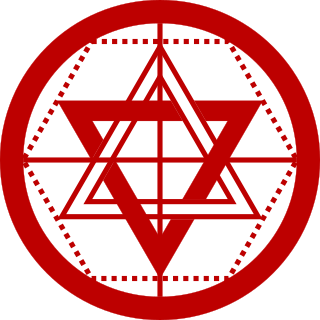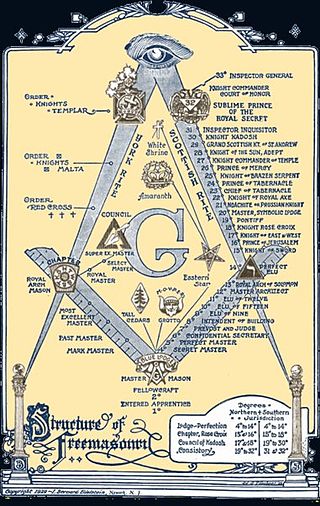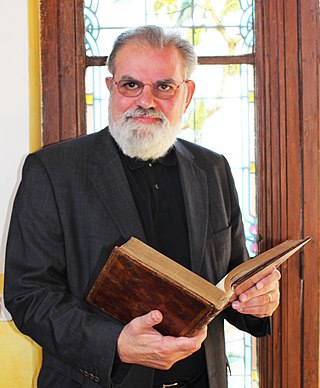
Martinism is a form of Christian mysticism and esoteric Christianity concerned with the fall of the first man, his materialistic state of being, deprived of his own, divine source, and the process of his eventual return, called 'Reintegration'.

The Knights Templar, full name The United Religious, Military and Masonic Orders of the Temple and of St John of Jerusalem, Palestine, Rhodes and Malta, is a fraternal order affiliated with Freemasonry. Unlike the initial degrees conferred in a regular Masonic Lodge, which only require a belief in a Supreme Being regardless of religious affiliation, the Knights Templar is one of several additional Masonic Orders in which membership is open only to Freemasons who profess a belief in Christianity. One of the obligations entrants to the order are required to declare is to protect and defend the Christian faith. The word "United" in its full title indicates that more than one historical tradition and more than one actual order are jointly controlled within this system. The individual orders 'united' within this system are principally the Knights of the Temple, the Knights of Malta, the Knights of St Paul, and only within the York Rite, the Knights of the Red Cross.

There are many organisations and orders which form part of the widespread fraternity of Freemasonry, each having its own structure and terminology. Collectively these may be referred to as Masonic bodies, Masonic orders, Concordant bodies or appendant bodies of Freemasonry.

The Illuminati is a name given to several groups, both real and fictitious. Historically, the name usually refers to the Bavarian Illuminati, an Enlightenment-era secret society founded on 1 May 1776 in Bavaria, today part of Germany. The society's stated goals were to oppose superstition, obscurantism, religious influence over public life, and abuses of state power. "The order of the day," they wrote in their general statutes, "is to put an end to the machinations of the purveyors of injustice, to control them without dominating them." The Illuminati—along with Freemasonry and other secret societies—were outlawed through edict by Charles Theodore, Elector of Bavaria, with the encouragement of the Catholic Church, in 1784, 1785, 1787 and 1790. During subsequent years, the group was generally vilified by conservative and religious critics who claimed that the Illuminati continued underground and were responsible for the French Revolution.
Freemasonry in Denmark was first established in 1743 and is today represented by a number of Grand Lodges. The oldest and biggest Masonic Grand Lodge in Denmark is the Danish Order of Freemasons, in English also known as the Grand Lodge of Denmark.
The Rite of Strict Observance was a Rite of Freemasonry, a series of progressive degrees that were conferred by the Order of Strict Observance, a Masonic body of the 18th century.
With 84 lodges and 3’350 members, the Grand Lodge Alpina of Switzerland (GLAS) is a Swiss Masonic obedience founded in 1844.
The Primitive Scottish Rite is a Masonic Rite. According to Robert Ambelain, an esotericist who "awakened" it in 1985, it was the rite used by the St. John of Scotland Lodge in Marseille, which was introduced to France in Saint-Germain-en-Laye from 1688; these claims are disputed by historians.

Ordre Reaux Croix is a Martinist order established in 2002, on the 250th anniversary of the founding of the Elus Cohens of Martinez de Pasqually. ORC is an international Order, with its Grand Lodge in Norway, and jurisdictions in Sweden, United States, Canada, Argentina, Spain, Greece, Brazil and England.

Jean-Baptiste Willermoz was a French Freemason and Martinist who played an important role in the establishment of various systems of Masonic high-degrees in his time in both France and Germany.

Pierre Mollier is a French historian and freemason, born in Lyon in 1961. A graduate of Sciences Po, he holds a master's degree in Religious Studies, and is the director of the library, archives, and museum for the Grand Orient de France.

Within the context of Freemasonry, the Chamber of Reflection, often abbreviated as C.O.R., and alternatively known as the Room of Reflection, Reflection Cabinet, or Meditation Cabinet, plays a pivotal role in the initiation process. This chamber serves as a dedicated space where a critical component of the initiation ritual unfolds, prompting the candidate to undergo a period of isolation designed to foster introspection and self-examination. The experience within the Chamber of Reflection is enriched by the presence of symbolic objects and thought-provoking phrases, which may exhibit minor variations across different Masonic rites and traditions.

Karl Gotthelf, Baron von Hund und Altengrotkau was a German freemason. In 1751, he founded the Rite of Strict Observance.

The Order of Knight-Masons Elect Priests of the Universe or simply Élus Coëns, was a theurgical organisation founded by Martinez de Pasqually. It appeared in France in the second half of the 18th century and is the first branch of Martinist tradition, otherwise known as Martinezism.
Masonic myths occupy a central place in Freemasonry. Derived from founding texts or various biblical legends, they are present in all Masonic rites and ranks. Using conceptual parables, they can serve Freemasons as sources of knowledge and reflection, where history often vies with fiction. They revolve mainly around the legendary stories of the construction of Solomon's temple, the death of its architect Hiram, and chivalry. Some of the original mythical themes are still part, to a greater or lesser extent and explicitly, of the symbols that make up the corpus and history of speculative Freemasonry. Some myths, however, have had no real posterity, but can still be found in some high grades, or in the symbolism of some rituals. Others borrow from the medieval imagination or from religious mysticism, and do not bother with historical truths to create legendary filiations with vanished guilds or orders.
The Philosophical Scottish Rite is a Masonic rite that was established in Paris in 1776 by the hermetist Alexandre Boileau, who was a disciple of Antoine-Joseph Pernéty. This rite is known for its unique structure and progression through various degrees.
Le Rite Primitif de Narbonne or Rite Primitif des Philadelphes, is a Masonic rite that was introduced in 1759, brought from Prague by Vicomte de Chefdebien d'Aigrefeuille.
The Rite des philalèthes(Rite of the Philalethes) comes from, Philalèthes or philalètes, which translates to: friend or seeker of truth, from the Greek Philos, friend and alètheia, truth, is in freemasonry, the name given to the Rite of the Philalethes and its practitioners. This system of philosophical or mystical Freemasonry was founded in 1773 by Marquis Charles-Pierre-Paul Savalette de Langes within the Masonic lodge "Les Amis réunis", of which he was the worshipful master and a founding member. This rite continued until the death of its founder in 1797.
The Adonhiramite Rite is a Masonic system consisting of 13 grades or degrees, created in 1787 by the German occultist Baron von Tschoudy (1727-1769). It was published in Tschoudy's book Recueil précieux de la Maçonnerie Adonhiramique. This rite combines Templar, Rosicrucian and other esoteric influences into a unique Masonic structure.












